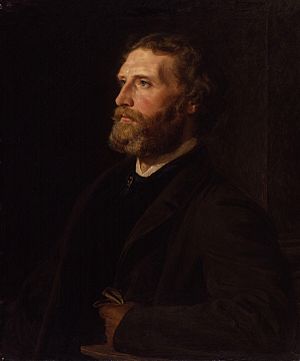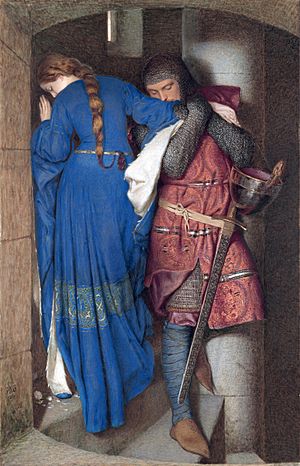Frederic William Burton facts for kids
Quick facts for kids
Frederic William Burton
|
|
|---|---|

Painting of Sir Frederic William Burton by Henry Tanworth Wells, 1863
|
|
| Born | 8 April 1816 |
| Died | 16 March 1900 London
|
Sir Frederic William Burton (born April 8, 1816, in Wicklow – died March 16, 1900, in London) was a famous Irish painter and art expert. He was the third director of the National Gallery in London for 20 years, starting in 1874.
Two of Burton's most well-known watercolour paintings are The Aran Fisherman's Drowned Child (from 1841) and The Meeting on the Turret Stairs (from 1864). These are kept at the National Gallery of Ireland. In 2012, The Meeting on the Turret Stairs was even voted Ireland's favourite painting by the public!
Contents
About Frederic William Burton
Frederic William Burton was born in County Wicklow, Ireland. When he was six years old, his family moved to County Clare on the west coast of Ireland. He was the third son of Samuel Frederick Burton and Hanna Mallett.
His Artistic Journey

Frederic was educated in Dublin. He became an associate of the Royal Hibernian Academy when he was 21. Just two years later, he became a full academician. In 1842, his art was shown at the Royal Academy.
He loved to travel and visited many parts of Europe, including Germany and Bavaria. These trips helped him learn a lot about the works of famous old artists, known as the Old Masters. For seven years, starting in 1851, he even worked as a painter for Maximilian II of Bavaria.
Burton also worked with another artist, George Petrie, on drawings for archaeology. He was part of the council for the Royal Irish Academy and the Archaeological Society of Ireland.
He became an associate of the Royal Society of Painters in Watercolours in 1855, and a full member the next year. He was given the title of Sir in 1884. He also received an honorary law degree from Dublin in 1889. Frederic William Burton passed away in Kensington, west London, and is buried in Mount Jerome Cemetery, Dublin.
Leading the National Gallery
In 1874, Frederic Burton was chosen to be the director of the National Gallery in London. He took over from Sir William Boxall.
During his time as director, he helped the gallery get many important artworks. For example, in 1874, he helped buy a large art collection from Alexander Barker. This collection included famous paintings like Nativity by Piero della Francesca and Venus and Mars by Botticelli. In 1876, the gallery also received 94 paintings as a gift from Wynne Ellis. Most of these were by Dutch artists, but there were also works by Pollaiuolo, Bouts, and Canaletto.
Over the 20 years he was director, he bought more than 500 new artworks for the gallery. Some of these famous purchases include:
- Virgin of the Rocks by Leonardo da Vinci
- Ansidei Madonna by Raphael
- Equestrian portrait of Charles I by Anthony van Dyck
- Ambassadors by Hans Holbein the Younger
- Admiral Pulido Pareja by Diego Velázquez (though later thought to be by Velázquez's assistant, Juan Bautista Martínez del Mazo)
He also added many early Italian paintings to the collection.
Art Exhibitions
The National Gallery of Ireland held a special exhibition of Burton's artwork. It ran from October 25, 2017, to January 14, 2018.
His Influence
Frederic William Burton's painting, The Meeting on the Turret Stairs, is very famous. In 2015, an Irish artist named Joe Caslin created a large mural that was inspired by this painting. This mural was part of a campaign in Ireland about marriage equality.
Images for kids
-
The Aran Fisherman's Drowned Child, 1841, National Gallery of Ireland, Dublin



